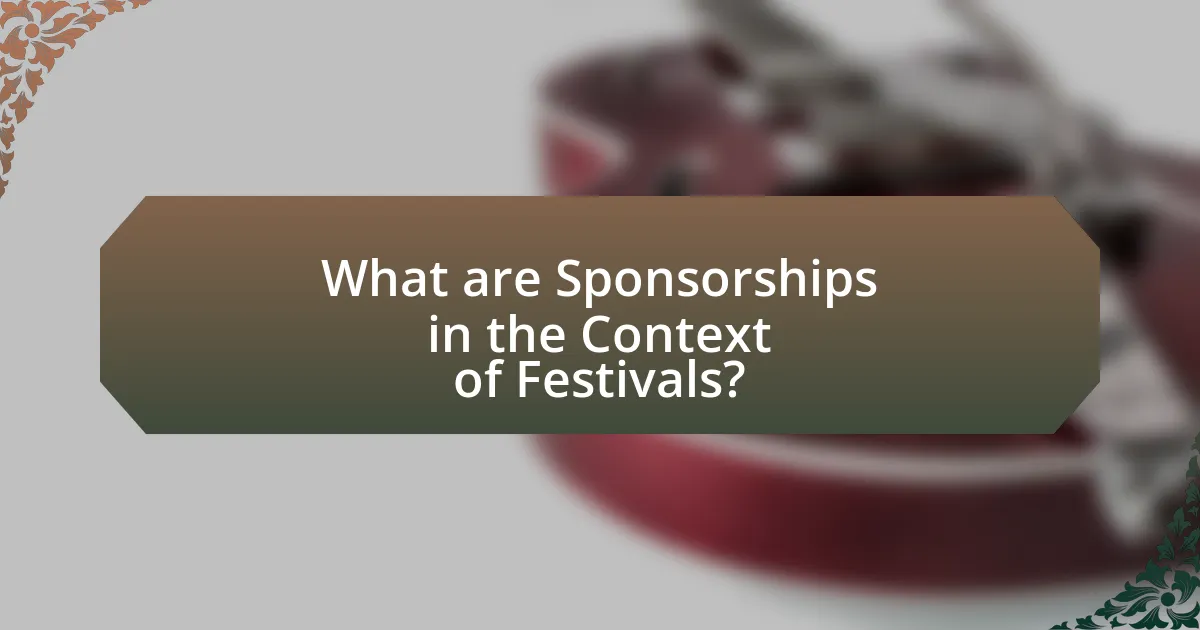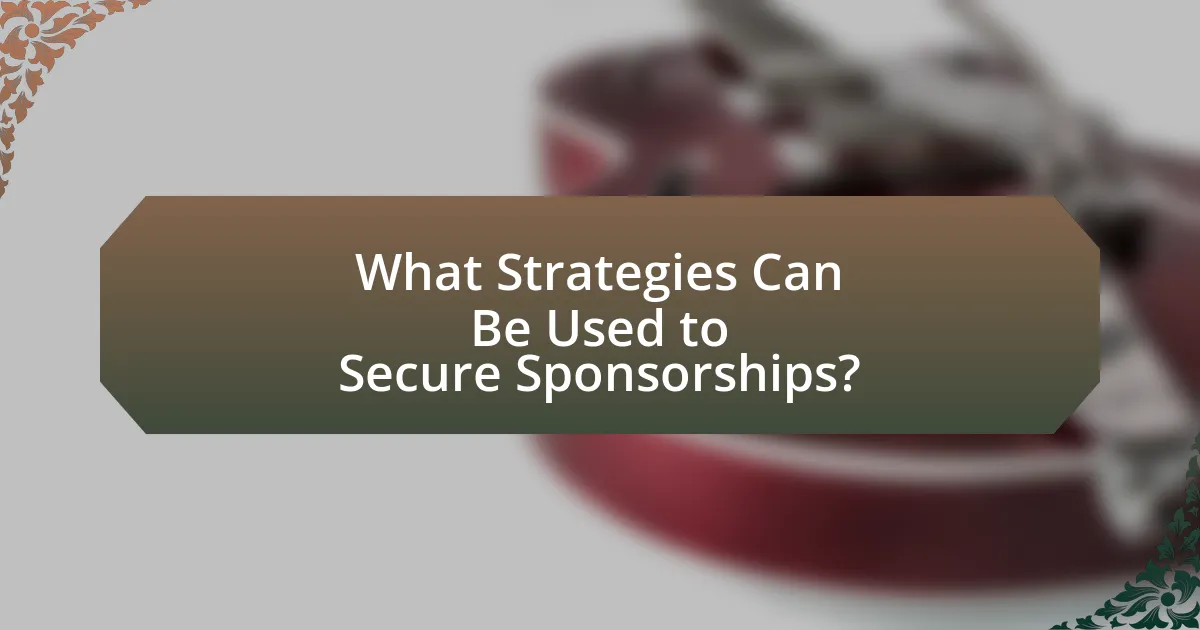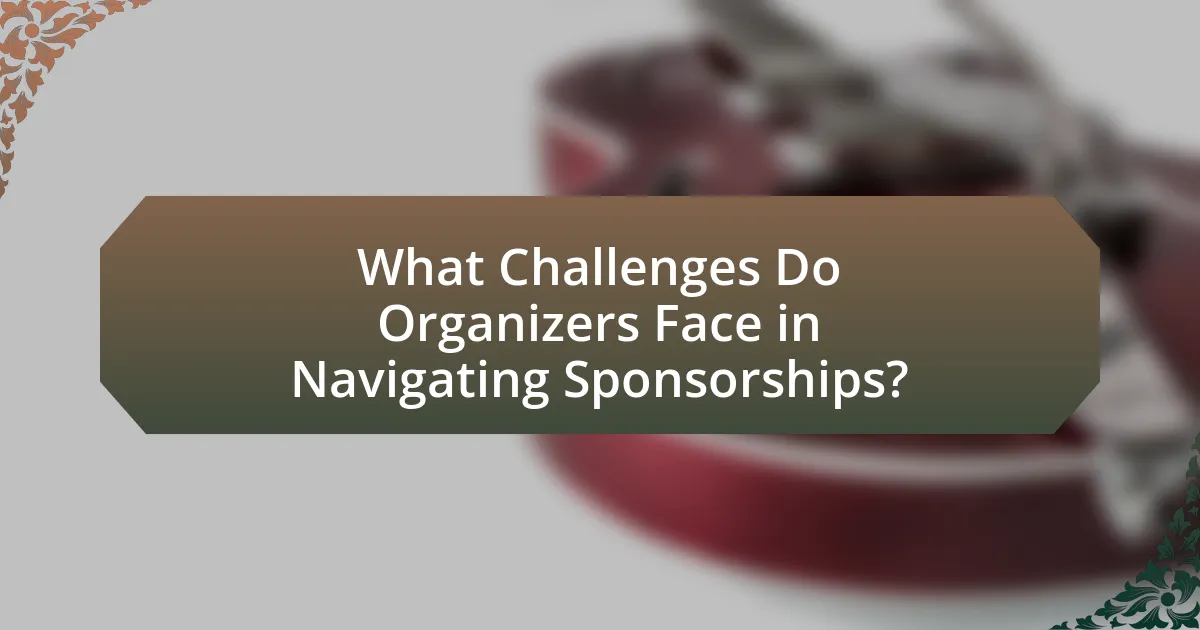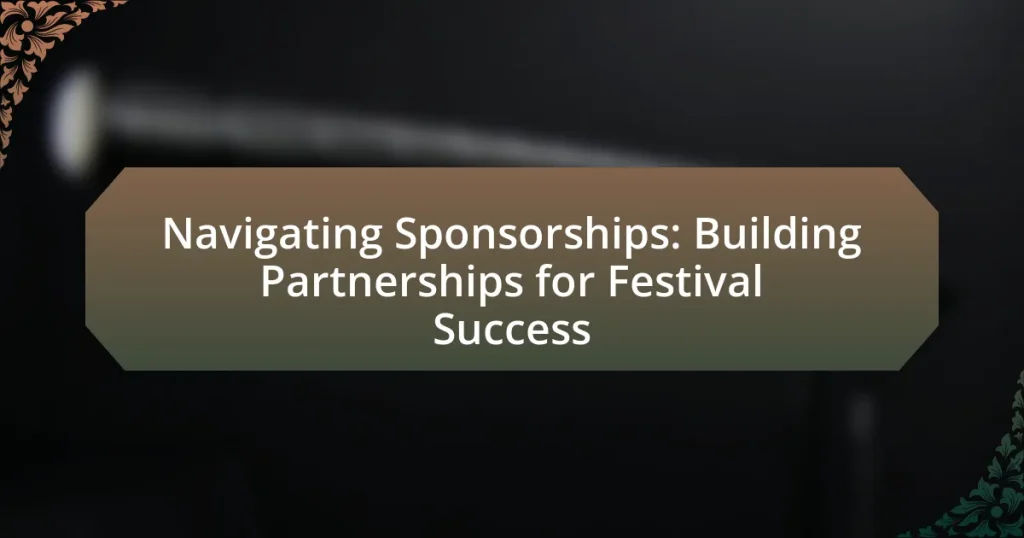The article focuses on the significance of sponsorships in the context of festivals, highlighting how financial and in-kind support from businesses enhances the festival experience while promoting brand visibility. It discusses the various types of sponsorships, such as title and product sponsorships, and their contributions to festival success through increased funding, audience engagement, and marketing reach. Additionally, the article outlines strategies for securing sponsorships, managing expectations, and measuring success, emphasizing the importance of aligning sponsor goals with event objectives to foster mutually beneficial partnerships. Key challenges faced by organizers in navigating sponsorships are also addressed, along with best practices for creating effective sponsorship proposals.

What are Sponsorships in the Context of Festivals?
Sponsorships in the context of festivals refer to financial or in-kind support provided by businesses or organizations to enhance the festival experience while promoting their brand. These partnerships often involve the sponsor’s logo displayed at the event, promotional materials, and opportunities for direct engagement with attendees. According to a study by the Event Marketing Institute, 74% of consumers have a more positive perception of a brand after participating in a sponsored event, highlighting the effectiveness of sponsorships in building brand awareness and loyalty.
How do sponsorships contribute to festival success?
Sponsorships significantly contribute to festival success by providing essential funding and resources that enhance the overall experience. Financial support from sponsors allows festivals to secure high-quality talent, improve infrastructure, and offer engaging activities, which attract larger audiences. For instance, a study by the Event Marketing Institute found that 70% of festival organizers reported increased attendance due to effective sponsorship partnerships. Additionally, sponsors often bring their marketing expertise and networks, amplifying the festival’s reach and visibility through promotional campaigns. This collaboration not only boosts ticket sales but also fosters a positive brand association for sponsors, creating a mutually beneficial relationship that drives long-term success for both the festival and its partners.
What types of sponsorships are commonly seen in festivals?
Common types of sponsorships seen in festivals include title sponsorships, presenting sponsorships, and product sponsorships. Title sponsorships involve a company paying to have its name associated with the festival, often leading to significant brand visibility. Presenting sponsorships typically allow a brand to be prominently featured in promotional materials and at the event, enhancing its exposure. Product sponsorships involve companies providing goods or services in exchange for branding opportunities, such as food and beverage vendors at music festivals. These sponsorship types are essential for funding and enhancing the overall festival experience, as they help cover operational costs and attract larger audiences.
How do sponsorships enhance the festival experience for attendees?
Sponsorships enhance the festival experience for attendees by providing additional resources that improve event quality and engagement. These partnerships often lead to increased funding, which can be allocated to better facilities, enhanced entertainment options, and interactive activities that enrich the overall atmosphere. For instance, a study by the Event Marketing Institute found that 74% of attendees reported a more enjoyable experience at events with strong sponsorship presence, as it often translates to higher production values and unique experiences, such as exclusive brand activations or giveaways.
Why are partnerships important for festival organizers?
Partnerships are crucial for festival organizers because they provide essential resources, funding, and expertise that enhance the overall event experience. Collaborating with sponsors and local businesses allows organizers to secure financial support, which can cover costs such as venue rental, marketing, and talent booking. For instance, a study by the Event Marketing Institute found that 84% of event organizers believe sponsorships significantly improve their event’s quality and reach. Additionally, partnerships can facilitate access to a wider audience through cross-promotion, leveraging the networks of both the festival and its partners. This synergy not only boosts attendance but also fosters community engagement, making the festival more impactful and sustainable.
What role do partnerships play in resource allocation?
Partnerships play a crucial role in resource allocation by enabling organizations to pool resources, share expertise, and leverage networks for mutual benefit. In the context of festivals, partnerships can enhance funding opportunities, as sponsors often provide financial support in exchange for brand visibility and engagement. For instance, a study by the Event Marketing Institute found that 84% of consumers are more likely to engage with a brand after participating in a sponsored event, demonstrating the effectiveness of partnerships in attracting resources. Additionally, partnerships can facilitate access to venues, equipment, and volunteers, optimizing the overall resource distribution and enhancing the festival experience.
How can partnerships improve marketing and outreach efforts?
Partnerships can significantly enhance marketing and outreach efforts by leveraging combined resources and audiences. When organizations collaborate, they can pool their marketing budgets, share expertise, and access each other’s customer bases, resulting in broader reach and increased visibility. For instance, a study by the Harvard Business Review found that companies engaging in strategic partnerships can achieve up to 30% higher marketing effectiveness due to shared promotional activities and co-branded campaigns. This collaborative approach not only amplifies messaging but also fosters credibility, as audiences often trust recommendations from familiar brands.

What Strategies Can Be Used to Secure Sponsorships?
To secure sponsorships, organizations should develop a targeted approach that includes identifying potential sponsors, creating a compelling value proposition, and building relationships. Identifying potential sponsors involves researching companies that align with the festival’s audience and values, ensuring a mutual benefit. A compelling value proposition should clearly articulate the benefits sponsors will receive, such as brand exposure, audience engagement, and promotional opportunities. Building relationships through networking and personalized outreach can enhance trust and interest from potential sponsors. According to a study by IEG, 70% of sponsors prioritize partnerships that demonstrate a clear alignment with their marketing goals, underscoring the importance of a tailored approach.
How can festival organizers identify potential sponsors?
Festival organizers can identify potential sponsors by researching companies that align with the festival’s target audience and values. This involves analyzing the demographics of festival attendees and matching them with brands that have previously sponsored similar events or have a vested interest in reaching that audience. For instance, a music festival may seek sponsors from beverage companies, local businesses, or brands that cater to the lifestyle of music fans. Additionally, utilizing platforms like LinkedIn to connect with marketing professionals in relevant industries can facilitate sponsorship discussions. According to a study by Eventbrite, 78% of event organizers find success in sponsorships by targeting brands that resonate with their audience, demonstrating the effectiveness of this approach.
What criteria should be considered when selecting sponsors?
When selecting sponsors, alignment with brand values is crucial. Sponsors should share similar target audiences and values to ensure a cohesive partnership that resonates with attendees. Additionally, financial stability is important; sponsors must have the resources to fulfill their commitments and support the event effectively. The sponsor’s reputation also matters; a positive public image can enhance the festival’s credibility, while a negative one can harm it. Furthermore, the sponsor’s previous experience with similar events can indicate their reliability and effectiveness in partnership. Lastly, the potential for mutual benefits should be assessed; both parties should gain value from the sponsorship to foster a long-term relationship.
How can organizers approach sponsors effectively?
Organizers can approach sponsors effectively by conducting thorough research to identify potential sponsors whose values align with the event’s mission. This alignment increases the likelihood of a successful partnership, as sponsors are more inclined to support events that resonate with their brand identity. For instance, a music festival focused on sustainability should target companies in the eco-friendly sector, as evidenced by a study from the Event Marketing Institute, which found that 74% of sponsors prefer partnerships that reflect their corporate social responsibility goals. Additionally, organizers should create a compelling sponsorship proposal that clearly outlines the benefits for the sponsor, including audience demographics, engagement opportunities, and potential return on investment. This strategic approach not only enhances the appeal of the sponsorship but also fosters long-term relationships between organizers and sponsors.
What are the best practices for creating sponsorship proposals?
The best practices for creating sponsorship proposals include clearly defining the sponsorship opportunity, outlining the benefits for the sponsor, and providing a detailed budget. Clearly defining the opportunity involves specifying the event, audience demographics, and the unique aspects that make the sponsorship appealing. Outlining benefits should focus on how the sponsor’s brand will gain visibility, engage with the audience, and achieve marketing objectives. Providing a detailed budget helps sponsors understand the financial requirements and potential return on investment. According to a study by IEG, 70% of sponsors prioritize proposals that clearly articulate the value and benefits they will receive, reinforcing the importance of these best practices.
What key elements should be included in a sponsorship proposal?
A sponsorship proposal should include the following key elements: an executive summary, detailed information about the event or project, target audience demographics, sponsorship levels and benefits, marketing and promotional strategies, and a call to action. The executive summary provides a concise overview of the proposal, while the event details outline the purpose, goals, and significance of the festival. Target audience demographics help potential sponsors understand the reach and impact of their investment. Sponsorship levels and benefits clearly define what sponsors will receive in return for their support, such as branding opportunities and visibility. Marketing and promotional strategies demonstrate how the event will be marketed to maximize exposure for sponsors. Finally, a call to action encourages potential sponsors to engage and commit to the partnership. These elements collectively create a compelling case for sponsorship, enhancing the likelihood of securing support.
How can organizers tailor proposals to meet sponsor needs?
Organizers can tailor proposals to meet sponsor needs by conducting thorough research on the sponsor’s objectives, target audience, and brand values. This approach allows organizers to align their event’s goals with the sponsor’s marketing strategy, ensuring mutual benefits. For instance, if a sponsor aims to enhance brand visibility among young adults, organizers can highlight how their festival attracts that demographic through specific programming and promotional efforts. Additionally, including data on past event attendance, audience engagement metrics, and potential media exposure can further demonstrate the value of the partnership. By customizing the proposal to reflect the sponsor’s interests and providing concrete evidence of potential returns, organizers can create compelling and relevant sponsorship opportunities.

What Challenges Do Organizers Face in Navigating Sponsorships?
Organizers face several challenges in navigating sponsorships, primarily including aligning sponsor goals with event objectives, securing adequate funding, and managing sponsor expectations. Aligning goals is crucial because sponsors seek visibility and brand alignment, while organizers aim for audience engagement and event success. Securing adequate funding can be difficult, as competition for sponsorship dollars is high, with many events vying for the same resources. Additionally, managing sponsor expectations involves clear communication and delivering on promises, which can be complex when multiple stakeholders are involved. These challenges are supported by industry reports indicating that 70% of event organizers cite difficulty in finding sponsors that match their event’s vision and audience.
What common obstacles arise when seeking sponsorships?
Common obstacles when seeking sponsorships include a lack of alignment between the sponsor’s goals and the event’s objectives, insufficient data to demonstrate potential return on investment, and competition from other events vying for the same sponsors. Misalignment can lead to sponsors perceiving the partnership as unbeneficial, while inadequate data may hinder the ability to convince sponsors of the event’s value. Additionally, high competition can dilute the appeal of sponsorship opportunities, making it challenging to secure commitments. These factors collectively contribute to the difficulties faced in obtaining sponsorships for events.
How can organizers overcome budget constraints?
Organizers can overcome budget constraints by actively seeking sponsorships and partnerships with local businesses and organizations. By creating mutually beneficial relationships, organizers can secure financial support or in-kind contributions, which can significantly reduce costs. For instance, festivals that partner with local vendors often receive discounts on supplies or services, while sponsors gain visibility and marketing opportunities. Research indicates that festivals with strong sponsorship programs can increase their budgets by up to 30%, demonstrating the effectiveness of this approach in alleviating financial limitations.
What strategies can be employed to manage sponsor expectations?
To manage sponsor expectations effectively, clear communication and regular updates are essential. Establishing a detailed sponsorship agreement that outlines roles, responsibilities, and deliverables helps set realistic expectations from the outset. Additionally, maintaining open lines of communication throughout the partnership allows for addressing concerns promptly and adjusting strategies as needed. Research indicates that 70% of sponsorships fail due to misaligned expectations, highlighting the importance of proactive engagement and transparency in managing sponsor relationships.
How can organizers measure the success of sponsorships?
Organizers can measure the success of sponsorships through key performance indicators (KPIs) such as brand visibility, audience engagement, and return on investment (ROI). Brand visibility can be assessed by tracking metrics like logo impressions, social media mentions, and media coverage during the event. Audience engagement can be evaluated through surveys, attendance numbers, and participation in sponsored activities. ROI can be calculated by comparing the financial benefits gained from the sponsorship against the costs incurred, often using metrics like increased sales or leads generated during the event. These methods provide concrete data that demonstrate the effectiveness of sponsorships in achieving organizational goals.
What metrics are useful for evaluating sponsorship effectiveness?
Key metrics for evaluating sponsorship effectiveness include brand awareness, audience engagement, return on investment (ROI), and social media reach. Brand awareness can be measured through surveys and brand recall studies, indicating how well the sponsorship has increased visibility. Audience engagement is assessed through metrics such as attendance numbers, participation in sponsored activities, and interactions during the event. ROI quantifies the financial return relative to the sponsorship cost, often calculated by comparing increased sales or leads generated from the sponsorship. Social media reach can be evaluated through metrics like impressions, shares, and follower growth, reflecting the sponsorship’s impact on online presence. These metrics provide a comprehensive view of how effectively a sponsorship meets its objectives.
How can feedback from sponsors and attendees inform future partnerships?
Feedback from sponsors and attendees can significantly inform future partnerships by providing insights into their experiences and expectations. This feedback allows organizers to identify strengths and weaknesses in their current offerings, enabling them to tailor future events to better meet the needs of both sponsors and attendees. For instance, if sponsors express a desire for more visibility or engagement opportunities, organizers can adjust their marketing strategies or event layouts accordingly. Similarly, attendee feedback regarding programming or amenities can guide improvements that enhance overall satisfaction and retention. Research indicates that events that actively incorporate feedback see a 20% increase in sponsor retention and a 15% increase in attendee satisfaction, demonstrating the tangible benefits of utilizing feedback for partnership development.
What are the key takeaways for successful festival sponsorships?
Successful festival sponsorships require clear alignment between the sponsor’s brand values and the festival’s audience. This alignment ensures that the sponsorship resonates with attendees, enhancing brand visibility and engagement. Additionally, establishing measurable goals for the sponsorship, such as increased brand awareness or sales, allows for effective evaluation of the partnership’s success. Research indicates that festivals with well-defined sponsorship strategies see a 30% increase in sponsor satisfaction and retention rates. Furthermore, fostering ongoing communication and collaboration between sponsors and festival organizers can lead to innovative marketing opportunities, creating a win-win scenario for both parties.
What tips can help organizers build lasting partnerships with sponsors?
Organizers can build lasting partnerships with sponsors by establishing clear communication and aligning goals. Effective communication ensures that both parties understand expectations, deliverables, and timelines, which fosters trust. Aligning goals means that organizers should identify sponsors whose values and objectives match their own, creating a mutually beneficial relationship. Research indicates that partnerships with aligned objectives lead to higher satisfaction and retention rates, as seen in a study by the Association of Fundraising Professionals, which found that 70% of successful sponsorships stem from shared values and goals. Additionally, providing regular updates and acknowledging sponsors’ contributions can enhance engagement and loyalty, further solidifying the partnership.
How can organizers ensure mutual benefits in sponsorship agreements?
Organizers can ensure mutual benefits in sponsorship agreements by clearly defining objectives and expectations for both parties. This involves conducting thorough research to understand the sponsor’s goals, such as brand visibility or audience engagement, and aligning them with the event’s objectives, like increasing attendance or enhancing the festival’s reputation.
Additionally, organizers should create tailored sponsorship packages that offer value, such as exclusive branding opportunities, targeted marketing, and measurable outcomes. For instance, a study by IEG found that 70% of sponsors seek measurable results from their investments, highlighting the importance of providing metrics that demonstrate the impact of the sponsorship.
Regular communication and feedback mechanisms throughout the partnership can also foster a collaborative environment, ensuring that both the organizer and the sponsor can adjust strategies as needed to maximize benefits. By focusing on these strategies, organizers can create win-win scenarios that enhance the success of both the event and the sponsor’s brand.
